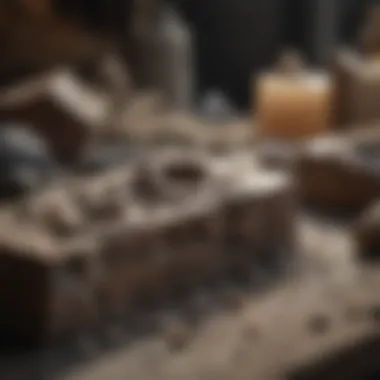Master the Art of Crafting Your Own Casting Mold for Rock and Fossil Preservation


Rock and Fossil Identification
As a dedicated rock and fossil enthusiast, understanding the types of rocks and fossils is paramount. Rocks can range from igneous, sedimentary, to metamorphic, each bearing unique characteristics indicative of their formation process. Fossils, on the other hand, showcase past life forms preserved in the Earth's crust. To identify these geological treasures, one must possess a keen eye for details such as color, texture, and any visible imprints. Utilizing tools like a magnifying glass, chisel, and brush can aid in the identification process, allowing collectors to unravel the secrets held within each specimen.
Collecting Tips and Techniques
Venturing into the realm of rock and fossil collection requires careful consideration and skill. Adopting best practices, such as obtaining landowner permission and adhering to local regulations, is essential when embarking on collecting expeditions. Identifying prime collecting sites entails research and exploration to locate areas rich in geological wonders. When extracting specimens, prioritize safety by using appropriate tools like rock hammers and safety goggles to avoid unnecessary harm. By following these techniques, collectors can amass a diverse array of rocks and fossils while respecting nature and its delicate balance.
Preservation and Display
Preserving collected rocks and fossils ensures their longevity and showcases their beauty for years to come. Utilizing techniques like cleaning with a soft brush and gentle water stream helps maintain the specimens' integrity without causing damage. Proper storage methods involve storing rocks in padded containers and fossils in acid-free paper to prevent degradation. When it comes to display, creativity knows no bounds. Incorporating shelves, shadow boxes, or even creating thematic arrangements adds an artistic touch to showcasing these geological wonders.
Geological Insights
Delving deeper into the geological world unveils a tapestry of formations and processes that have shaped the Earth over millennia. From the intricate layers of sedimentary rocks to the fiery origins of volcanic formations, each geological structure tells a unique story of our planet's history. Exploring the historical significance of rocks and fossils reveals clues to ancient environments and the evolution of life on Earth. Notable discoveries in the field continue to expand our understanding of the geological sciences, highlighting the endless possibilities waiting to be unearthed by passionate enthusiasts.
Introduction to Casting Molds
In the realm of rock and fossil enthusiasts, the crafting of casting molds holds a pivotal role in preserving and showcasing geological specimens with meticulous detail and authenticity. This section serves as a foundational pillar in the comprehensive guide, elucidating the essence of molding techniques for connoisseurs seeking to immortalize their prized findings. Exploring the intricate nuances of mold creation unveils a realm of artistic and scientific possibilities, elevating the aficionado's journey in the realm of geological preservation.
Understanding the Importance of Casting Molds
Preservation of Geological Specimens
The preservation of geological specimens stands as a cornerstone in the realm of casting molds, offering collectors a viable method to safeguard the integrity and intricate details of their cherished rocks and fossils. By encapsulating these specimens within meticulously crafted molds, enthusiasts can ensure long-term durability and protection against external elements that may jeopardize the specimens' pristine condition. This preservation technique not only honors the historical and scientific significance of each specimen but also enables collectors to create replicas that retain the essence of the original, catering to both aesthetic and scholarly pursuits.
Replication for Display and Study
Replication for display and study propels the utility of casting molds beyond mere preservation, amplifying the educational and aesthetic dimensions of geological exploration. Through replication, collectors can disseminate replicas of rare or delicate specimens for scholarly research, educational purposes, or public exhibition, enhancing accessibility to these geological wonders without compromising the integrity of the originals. This facet of casting molds empowers enthusiasts to delve deeper into the realms of paleontology, geology, and artistry, fostering a deeper understanding and appreciation for Earth's ancient treasures.
Benefits of Making Your Own Casting Mold
Customization of Designs
The ability to customize designs serves as a crowning advantage of creating one's casting mold, allowing enthusiasts to infuse their unique artistic vision into the replication process. By tailoring molds to specific geological specimens, collectors can accentuate distinct features, textures, and patterns, enabling a personalized touch that transcends mass-produced replicas. This customization not only fosters a sense of ownership and creativity but also grants individuals the freedom to experiment with diverse casting techniques, pushing the boundaries of traditional replication methods.


Cost-Effectiveness
Embracing the art of crafting casting molds invites a cost-effective alternative to acquiring commercially available replicas, providing enthusiasts with a budget-friendly approach to expanding their geological collections. By investing in essential materials and mastering the molding process, collectors can produce high-quality replicas at a fraction of the cost incurred by purchasing ready-made replicas. This financial efficiency not only amplifies the accessibility of geological replication but also nurtures a hands-on appreciation for the intricate art of mold-making.
Control Over Materials Used
The autonomy to control materials used in creating casting molds empowers enthusiasts to dictate the composition, quality, and sustainability of their replicas, aligning with personal preferences and ethical standards. By selecting silicone rubber, catalysts, and other essential components, collectors can ensure the longevity and safety of their molds while minimizing environmental impact. This meticulous control over materials not only enhances the overall craftsmanship of replicas but also instills a sense of responsibility and mindfulness in the preservation of geological treasures.
Materials Needed for Crafting Casting Mold
In the realm of rock and fossil enthusiasts, the significance of material selection for crafting casting molds cannot be overstated. The materials used are pivotal in ensuring the successful replication and preservation of geological specimens. By carefully choosing the right components, enthusiasts can enhance the longevity and quality of their mold-making process. The process of creating casting molds is a meticulous endeavor that demands precise materials to yield optimal results. Understanding the intricacies of these materials is essential for achieving the desired outcomes.
Essential Materials
Silicone Rubber
Silicone rubber stands out as a key component in the art of creating casting molds. Its flexibility, durability, and heat resistance make it a favored choice among enthusiasts. The pliable nature of silicone rubber allows for intricate details to be captured effectively, ensuring precise replication of geological specimens. Moreover, its ability to withstand high temperatures during the curing process makes it an ideal material for mold-making. Enthusiasts value silicone rubber for its tear-resistant properties, which contribute to the longevity of the molds. Although silicone rubber may require specific handling techniques, its numerous advantages outweigh any potential drawbacks, making it a prevalent choice in the creation of casting molds.
Catalyst
The catalyst plays a vital role in the setting process of silicone rubber. By initiating the curing reaction, the catalyst accelerates the solidification of the silicone rubber, facilitating the mold-making process. Its precise formulation ensures the proper hardening of the silicone rubber, resulting in a durable and long-lasting mold. Enthusiasts appreciate the catalyst for its efficiency in expediting the curing time, allowing for a faster turnaround in mold creation. While the catalyst's functionality is crucial, careful measurement and proportioning are necessary to achieve optimal results. Understanding the role of the catalyst is fundamental to mastering the art of creating casting molds.
Mixing Containers
Mixing containers serve as the vessels for blending silicone rubber and catalyst to create the mold-making mixture. The choice of containers is significant in ensuring thorough mixing and homogenous consistency of the materials. Enthusiasts must select containers that are clean, non-reactive, and appropriately sized for the mixing process. The design of mixing containers should facilitate easy stirring and pouring of the mold-making mixture. Properly chosen mixing containers contribute to the precision and quality of the mold-making process, enhancing the overall outcome. Attention to detail in selecting mixing containers is imperative to achieving successful results in crafting casting molds.
Optional Additions for Specific Molding Needs
Release Agents
Release agents play a crucial role in mold-making by preventing the silicone rubber from bonding to the geological specimen. Their non-stick properties enable easy demolding and preserve the integrity of both the mold and the original specimen. Enthusiasts appreciate release agents for their ability to enhance mold durability and lifespan. By applying release agents judiciously, enthusiasts can simplify the demolding process and maintain the quality of their molds over time. Understanding the benefits and application of release agents is essential for addressing specific molding needs effectively.
Colorants
Colorants offer enthusiasts the opportunity to customize their casting molds with vibrant pigments. Beyond aesthetic appeal, colorants serve a practical purpose in distinguishing different molds or highlighting specific features of geological specimens. Enthusiasts can utilize colorants to add visual interest and detail to their molds, enhancing their overall presentation. The selection of colorants should complement the intended use of the molds while ensuring compatibility with the silicone rubber mixture. By incorporating colorants thoughtfully, enthusiasts can elevate the visual impact of their casting molds and create unique, personalized pieces.
Preparing Your Geological Specimen


In the realm of crafting your own casting mold for rock and fossil preservation, the initial step of preparing your geological specimen holds paramount importance. This pivotal stage sets the foundation for the entire molding process, ensuring optimal results and preservation of your prized geological finds. By meticulously cleaning and drying the specimen, enthusiasts pave the way for a successful mold creation, free from imperfections or contaminants.
Cleaning and Drying the Specimen
Importance of Clean Surface
The significance of starting with a pristine, clean surface for your geological specimen cannot be overstated. Every speck of dirt, debris, or foreign particles left on the surface can potentially impact the quality and accuracy of the final mold. A clean surface not only aids in capturing fine details effectively but also prevents any unwanted irregularities in the mold. Enthusiasts should exercise precision and care during the cleaning process to guarantee a flawless replication of their specimens. Implementing thorough cleaning practices ensures that the resulting mold accurately portrays the intricate features of the original specimen, thereby enhancing the overall display and study experience.
Methods for Drying
Following the meticulous cleaning process, proper drying techniques play a critical role in preparing the geological specimen for molding. Utilizing appropriate methods such as air-drying or controlled heating facilitates the removal of moisture and ensures the surface is completely dry before proceeding to the molding phase. Effective drying not only prevents the formation of air bubbles within the mold but also promotes better adhesion of the silicone rubber during application. By carefully selecting the ideal drying method and allowing sufficient time for the specimen to dry completely, enthusiasts can enhance the overall quality and durability of the casting mold, allowing for precise reproduction of geological details.
Securing the Specimen for Molding
With the freshly cleaned and dried specimen in hand, the next crucial step involves securing it in the optimal position for molding. Choosing the right base material and employing suitable positioning techniques are essential elements that contribute to the successful creation of a high-quality casting mold. The stability and alignment of the specimen during the molding process greatly influence the accuracy and integrity of the final mold, highlighting the importance of proper specimen preparation.
Choosing the Right Base
When selecting a base material for securing the geological specimen, factors such as stability, compatibility with the specimen, and ease of manipulation come into play. The chosen base should provide adequate support and alignment for the specimen, ensuring it remains in the desired position throughout the molding process. By carefully considering the properties of different base materials and selecting the most suitable option, enthusiasts can minimize the risk of displacement or misalignment during molding, ultimately enhancing the precision and detail captured in the final mold.
Positioning Techniques
In addition to choosing the right base material, employing effective positioning techniques is crucial for securing the specimen securely and accurately. Whether utilizing clamps, supports, or custom positioning tools, enthusiasts must carefully position the specimen to reflect its natural orientation and alignment. Attention to detail during this phase contributes to the overall authenticity and detail captured in the mold, providing a faithful replication of the original geological specimen. By mastering the art of precise specimen positioning, enthusiasts can ensure the successful creation of a high-quality casting mold that accurately preserves the unique features of their geological finds.
Creating the Casting Mold
Creating the casting mold is a crucial step in the process of preserving geological specimens. To encapsulate the intricate details of rocks and fossils, a well-crafted mold is imperative. By meticulously crafting the mold, enthusiasts can ensure an accurate replication of the specimen for display and study purposes. The customizability afforded by creating a casting mold allows collectors to capture the unique features of each geological find with precision. Additionally, having control over the materials used in the mold-making process enables enthusiasts to tailor the mold to suit specific needs and preferences, making it a valuable asset in the preservation of geological treasures.
Mixing and Applying Silicone Rubber
Proper Ratios
When it comes to mixing and applying silicone rubber, achieving the proper ratios is paramount for the success of the molding process. The correct proportion of silicone to catalyst ensures that the mold sets effectively, capturing even the smallest intricacies of the specimen. Proper ratios are essential for achieving a durable and high-quality mold that accurately replicates the texture and details of the geological find. This meticulous approach guarantees that the casting mold withstands the test of time, providing collectors with a long-lasting preservation solution.
Techniques for Even Application


Ensuring an even application of silicone rubber is crucial in creating a flawless casting mold. Proper techniques guarantee uniform coverage, preventing air bubbles and inconsistencies in the mold. By adopting techniques that promote an even spread of the rubber, enthusiasts can avoid potential imperfections that may compromise the final mold. The meticulous application of silicone rubber not only enhances the durability of the mold but also contributes to the overall quality of the replication, allowing collectors to showcase their geological specimens with pride.
Curing and Demolding Process
Time and Temperature Considerations
The curing and demolding process requires careful consideration of time and temperature to achieve optimal results. Properly timing the curing process and controlling the temperature during demolding are critical factors in ensuring the integrity of the mold. By adhering to specific time and temperature guidelines, collectors can prevent premature demolding that may damage the mold or result in an imperfect replication. These considerations are essential for maintaining the structural integrity of the mold and safeguarding the details of the geological specimen.
Safe Removal of Mold
Safe removal of the mold is a crucial final step in the casting process to preserve the integrity of the replication. Implementing gentle and strategic techniques for mold removal reduces the risk of damage to both the mold and the original specimen. By prioritizing safe removal practices, enthusiasts can ensure that the casting mold remains intact and ready for subsequent use. This meticulous approach to demolding enhances the longevity of the mold, allowing collectors to revisit and reproduce their geological finds with ease.
Finishing Touches and Preservation
In this article, the section focusing on Finishing Touches and Preservation plays a crucial role in the overall process of crafting casting molds for rock and fossil enthusiasts. After meticulously creating the mold, attention to detail in finishing touches ensures a high-quality final product. Trimming and cleaning the mold are significant steps that help in enhancing the durability and aesthetic appeal of the mold. These finishing touches not only contribute to the overall preservation of geological specimens but also add a professional touch to the final mold.
Trimming and Cleaning the Mold
Removing Excess Rubber
Removing excess rubber from the mold is a pivotal aspect of the molding process. This step ensures that the mold's edges are precise and clean, eliminating any irregularities that may affect the replicating process. By carefully trimming away excess rubber, enthusiasts achieve a polished finish on the mold, enhancing its visual appeal and functionality. The key characteristic of removing excess rubber is precision, as even the slightest imperfection can impact the final mold's quality. This meticulous process of trimming ensures that the mold is perfectly shaped and ready for casting, reflecting the dedication to detail required in mold-making.
When considering the benefits of removing excess rubber, it is evident that a neat and well-trimmed mold contributes to the overall professionalism of the final product. Additionally, precision trimming ensures that there are no rough edges or deformities that could compromise the mold's integrity. While this step may be time-consuming, the superior quality achieved through careful trimming justifies the effort put into refining the mold.
Cleaning Techniques
Cleaning techniques are essential in maintaining the cleanliness and longevity of the mold. Proper cleaning procedures ensure that the mold remains free from dirt, debris, or any residue that may affect future castings. Utilizing suitable cleaning agents and methods tailored to the type of mold material is crucial in preserving the mold's integrity. The key characteristic of cleaning techniques lies in their ability to remove contaminants without damaging the mold surface, safeguarding its quality for repeated use.
The choice of cleaning techniques is pivotal in ensuring the longevity of the mold and preserving its intricate details. By employing gentle yet effective cleaning methods, enthusiasts can extend the mold's lifespan and maintain its functionality over time. While each cleaning technique may have its unique features, the common goal remains to keep the mold in pristine condition, ready for future casting projects.
Storage and Maintenance Tips
Proper Storage Conditions
Optimal storage conditions are paramount in preserving the quality and longevity of casting molds. Storing molds in a cool, dry place away from direct sunlight and extreme temperatures safeguards them from degradation. The key characteristic of proper storage conditions is stability, as fluctuations in temperature or humidity can adversely impact the mold's structure. By adhering to specific storage guidelines, enthusiasts can ensure that their molds remain in top condition for extended periods.
Proper storage conditions are a beneficial choice for this article as they emphasize the importance of caring for molds beyond the casting process. By investing in suitable storage solutions such as airtight containers or storage boxes, enthusiasts can protect their molds from dust, moisture, and potential damage. While the initial cost of adequate storage may be a consideration, the long-term benefits of well-maintained molds justify the investment.
Periodic Maintenance
Periodic maintenance is indispensable for preserving the functionality and integrity of casting molds. Regular inspection for wear and tear, cleaning, and minor repairs are essential to ensure that molds remain in optimal condition. The key characteristic of periodic maintenance is its proactive approach to mold care, preventing potential issues before they escalate. By implementing a routine maintenance schedule, enthusiasts can address any concerns promptly and prolong their mold's lifespan effectively.
The benefits of periodic maintenance in this article lie in its ability to extend the usability of molds and mitigate the effects of wear over time. Through regular upkeep and minor repairs, enthusiasts can maximize the performance and longevity of their molds, making them a worthwhile tool for ongoing casting projects. While periodic maintenance requires dedication and attention to detail, the rewards of well-maintained molds speak to the commitment to quality upheld by rock and fossil enthusiasts.







